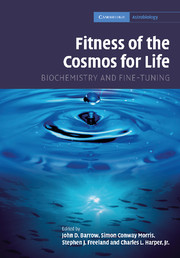Book contents
- Frontmatter
- Contents
- List of contributors
- Foreword: The improbability of life
- Preface
- Acknowledgments
- Part I The fitness of “fitness”: Henderson in context
- 1 Locating “fitness” and L. J. Henderson
- 2 Revisiting The Fitness of the Environment
- 3 Is fine-tuning remarkable?
- 4 Complexity in context: the metaphysical implications of evolutionary theory
- 5 Tuning fine-tuning
- Part II The fitness of the cosmic environment
- Part III The fitness of the terrestrial environment
- Part IV The fitness of the chemical environment
- Index
- References
3 - Is fine-tuning remarkable?
Published online by Cambridge University Press: 18 December 2009
- Frontmatter
- Contents
- List of contributors
- Foreword: The improbability of life
- Preface
- Acknowledgments
- Part I The fitness of “fitness”: Henderson in context
- 1 Locating “fitness” and L. J. Henderson
- 2 Revisiting The Fitness of the Environment
- 3 Is fine-tuning remarkable?
- 4 Complexity in context: the metaphysical implications of evolutionary theory
- 5 Tuning fine-tuning
- Part II The fitness of the cosmic environment
- Part III The fitness of the terrestrial environment
- Part IV The fitness of the chemical environment
- Index
- References
Summary
My contribution to this volume is that of a theologian interested in the relationship between science and religion. I will be asking whether what we are calling “fitness for life” and “biochemical fine-tuning” are consistent with, and perhaps even supportive of, the ageless religious convictions that the universe is here for a reason and that life is the intended consequence of divine love, wisdom, and creative power.
Today, it is particularly striking to many scientists that cosmic constants, physical laws, biochemical pathways, and terrestrial conditions are just right for the emergence and flourishing of life. It is not surprising, of course, that, as life exists, the cosmic and chemical conditions for it had to have been formatted for such an emergence. It would be remarkable, however, if the format could have been otherwise, and hence not right for life. During the universe's history, it now seems that only a very restricted set of physical conditions operative at several major junctures of emergence could have opened the gateways to life (Hogan, 2000). So, what principles lie behind the narrowing of the gateways that allowed only those conditions preparatory to life to flow through while excluding any cosmological principles, physical parameters, and chemical laws that would not have permitted such an outcome?
In the long, unfolding story of nature's development, any conceivable series of physical conditions or constants other than those that would lead to life have been tossed aside.
- Type
- Chapter
- Information
- Fitness of the Cosmos for LifeBiochemistry and Fine-Tuning, pp. 31 - 48Publisher: Cambridge University PressPrint publication year: 2007



